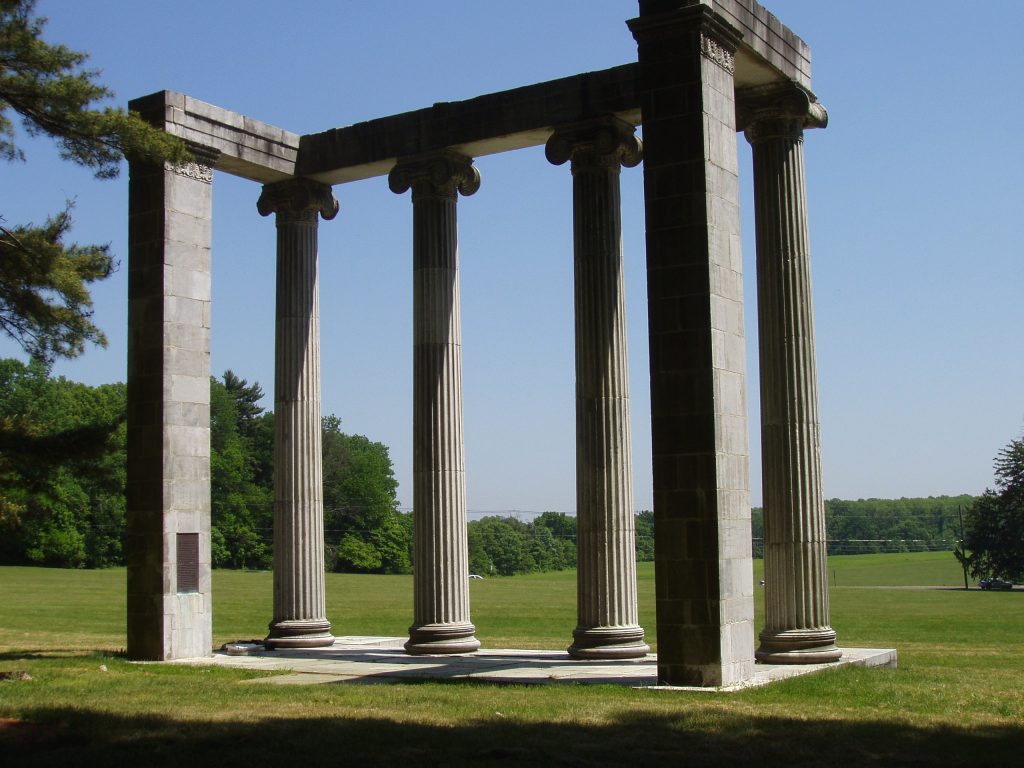Landmarks of the Princeton Battlefield
Explore the Historic Monuments and Structures That Keep History Alive
The Princeton Battlefield is home to several significant landmarks that serve as lasting symbols of resilience, sacrifice, and American independence. Each site tells a unique story about the Battle of Princeton and its impact on the fight for freedom.


The Thomas Clarke House – Witness to the Battle
Built in 1772, the Thomas Clarke House is the only surviving structure from the Battle of Princeton. It stood at the center of the conflict and served as a field hospital where both American and British soldiers—including General Hugh Mercer—were treated for their wounds.
Click to read: History of The Clarke House
Built in 1772, in the middle of what was then a 200-acre farm, the historic Clarke House is in outward appearance simply a white clapboard farm house. This historic building is central to the Battle of Princeton, fought on January 3rd, 1777, between the Continental Army under the command of General George Washington and British Crown forces.
The Clarkes, a third-generation Quaker family of the Stony Brook Quaker Settlement, turned the house into a field hospital after the battle, taking in both British and American wounded. Despite being cared for by Dr. Benjamin Rush (signer of the Declaration of Independence), American General Hugh Mercer died here nine days after the battle from being shot and bayoneted. Mercer County in New Jersey, site of the battle, is named in his honor.
The historic Clarke House is the only remaining structure from the time of the pivotal victory that set our Revolution on the road to success, and the heritage and meaning of our struggle for independence is within its walls. After nearly 250 years, age and weather have taken a toll; the wooden house is showing signs of deterioration, especially walls, near windows and doors, and most recently in the foundation.
Because of its inherent historic significance and because it houses exhibits critical to interpreting the history of the battle for the benefit of visitors, preserving this house is among the highest priorities for the Princeton Battlefield Society. We need stewards and caretakers to join us.
There are also needs to create new and to expand existing exhibits/displays to better interpret the Battle of Princeton and the historic Clarke House for the benefit of visitors. The History and Heritage Fund focuses on these needs, and PBS and State representatives are actively implementing plans for major interpretive changes. Contact the PBS for more information and to explore ways to participate in this initiative.
Quaker farmer Thomas Clarke builds a farmhouse on what will become the Battle of Princeton site.
The house is caught in crossfire during the battle and serves as a field hospital for both American and British wounded.
Clarke’s descendants continue to preserve and maintain the house as a historical landmark.
The Thomas Clarke House becomes part of the Princeton Battlefield State Park.
The house is open to visitors, featuring 18th-century artifacts, exhibits, and guided tours.

The Mercer Oak – A Living Symbol of the Revolution
The Mercer Oak has long been a symbol of the Battle of Princeton, standing near the spot where General Hugh Mercer was mortally wounded. Tradition holds that Mercer, refusing to surrender, was struck down near this tree, becoming a hero of the Revolution.
Click to read: History of The Mercer Oak

The Mercer Oak. Legend has it that General Hugh Mercer was laid against the original Mercer Oak when he was shot and bayoneted during the Battle of Princeton. It has been immortalized in the famous painting, “The Death of General Mercer at the Battle of Princeton January 3, 1777”, by John Trumbull.
Today, standing proudly and majestically on the Princeton Battlefield is a descendant of the Mercer Oak, which collapsed of old age in 2000.
General Hugh Mercer is mortally wounded near a large white oak during the Battle of Princeton.
The Mercer Oak becomes a well-known symbol of courage and sacrifice.
After standing for over 200 years, the original Mercer Oak falls due to age and weather.
A direct descendant of the Mercer Oak is planted in the same location, continuing its legacy.
The tree stands as a living memorial to General Mercer and the soldiers who fought for independence.

The Colonnade – A Monument to Memory
Standing tall at the battlefield’s edge, the Colonnade is a solemn tribute to the sacrifices made here. Originally part of a 19th-century mansion designed by architect Thomas Ustick Walter (who also designed the U.S. Capitol dome), the Colonnade was moved to its current location in 1956 as a memorial to fallen soldiers.
Click to read: History of Colonnade and Memorial Grove
The Ionic Colonnade that graces the western side of the battlefield park stands near the original location of the home of William Clarke, one of the brothers who farmed the surrounding land at the time of the battle. The columns and lintel actually originated as the portico of the mansion of Philadelphia merchant Matthew Newkirk, who had commissioned Thomas Walter, later the designer of the dome of the U.S. Capitol, for its construction. When Newkirk’s home was demolished around 1900, the colonnade was salvaged and transported to Princeton to become the entrance of Mercer Manor, another distinguished home that stood on the edge of the battlefield until it was destroyed by fire in the 1950s. At that time, the Institute for Advanced Study owned the property and donated its portico to the State of New Jersey. The Colonnade was dedicated where it stands in 1959, and declared a National Historic Monument in 1962.
The Colonnade is more than an architectural curiosity, though, since it is placed to serve as both an entrance and marker for the gravesite of fallen soldiers that lies nearby. A plaque on the portico notes:
“In the memorial grove beyond you, those who fell in the Battle of Princeton, both American and British, lie buried. The historic portico in which you stand was re-erected here to mark the entrance to the tomb of these unknown soldiers of the Revolution”
The memorial was erected in 1918, in memory of the thirty-six unknowns buried here, including fifteen American and twenty-one British soldiers. The words engraved on the tablet are those of Alfred Noyes (1880 – 1958), taken from his poem “Princeton” (1917). Noyes was a visiting professor at Princeton University, and later became Poet Laureate of England. He wrote his poem 140 years after the battle, at a time when American and British soldiers were fighting together in support of their common heritage of freedom. The opening lines of the poem are quoted on the plaque:
“Here Freedom stood by slaughtered friend and foe,
And, ere the wrath paled or that sunset died,
Looked through the ages; then, with eyes aglow,
Laid them to wait that future, side by side.”
The Colonnade can be considered a fitting tribute both to the brave Americans who fell at Princeton and, by echoing the artistry of ancient Greece, a reminder of the long history of the ideals of freedom and self-government for which they fought.
Architect Thomas Ustick Walter designs a grand mansion in Philadelphia featuring the Colonnade.
The Colonnade becomes part of Mercer Manor, an estate in Princeton.
After Mercer Manor is destroyed in a fire, the Colonnade is relocated to the Princeton Battlefield as a memorial to fallen soldiers.
The Colonnade stands as a place of reflection and remembrance, honoring both American and British soldiers who fought at Princeton.
The Princeton Battlefield Society relies on the support of history enthusiasts, educators, volunteers, and donors to continue our mission.
